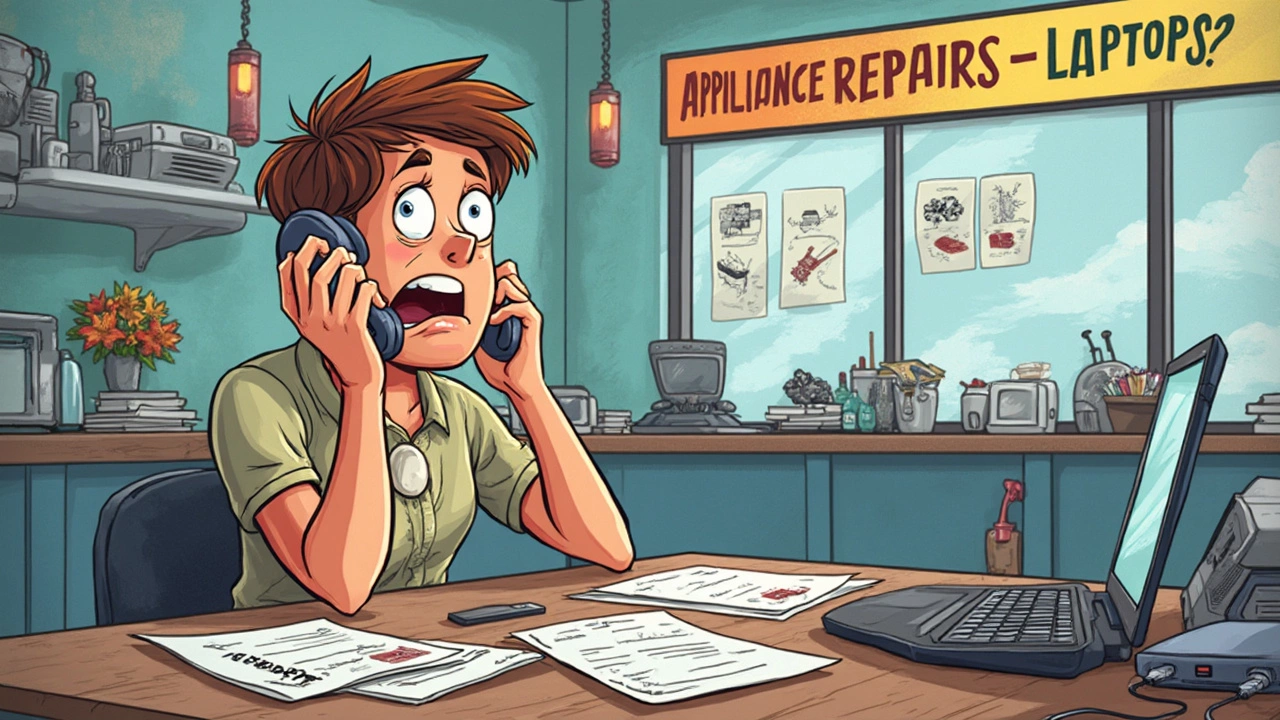Ever tried to get your laptop fixed and the repair shop told you, "Sorry, we only handle appliances"? It happens more often than you’d think. There's a real debate about what actually counts as an appliance—and laptops land right in the gray zone.
Unlike your fridge or washing machine, laptops aren’t usually seen as appliances by repair folks or warranty companies. But why? It all boils down to how we use them, what’s inside, and who fixes them. This split matters when you're figuring out where to go for service, what sort of warranty you have, or even whether your homeowner’s policy will cover a spill.
If you’re tired of the runaround and want the inside scoop, stick around. You’ll get answers that can potentially save you money and a lot of headaches.
- What Makes an Appliance—And Does a Laptop Qualify?
- How Is a Laptop Treated During Repairs?
- Warranty Coverage: Appliances vs. Electronics
- Tips for Laptop Care and Service
What Makes an Appliance—And Does a Laptop Qualify?
Let’s clear up what an appliance actually is. Most people—and even big retailers—define appliances as tools or machines that handle household chores. Think about your dishwasher, coffee maker, microwave, or washing machine. These are built with heavy-duty parts and usually stay in the same spot for years. They’re not supposed to travel, and nobody expects them to fit in a backpack.
On the flip side, a laptop is portable and personal. It’s more about work, play, and communication than scraping burnt toast out of the toaster. Laptops generally have delicate parts like circuit boards, batteries, and screens—much closer to what’s inside your phone or TV, not your blender.
| Device | Typical Use | Repair Category |
|---|---|---|
| Fridge | Food storage | Appliance |
| Laptop | Work/entertainment | Electronics |
| Microwave | Cooking | Appliance |
| Smartphone | Communication | Electronics |
The U.S. Department of Energy keeps it simple: appliances are "devices which use energy to perform a specific household task." Laptops don’t really fit that definition. Here’s what a tech repair expert told Consumer Reports:
“In the repair world, appliances refer to devices like ranges or washing machines. Laptops are considered consumer electronics—they’re a whole different ballgame.”
Insurance and service companies also see it this way. Your home warranty may cover fridges but probably not your laptop. Gadget and electronics plans are an entirely different category, which means calling the appliance repair guy for your cracked laptop screen won’t get you far.
So, while your laptop might feel as essential as a fridge, it’s just not in the same league. Understanding this helps you know where to go (and who to call) when that blue screen of death hits.
How Is a Laptop Treated During Repairs?
You might expect a laptop to get the same treatment as your microwave or dishwasher when it breaks, but it doesn’t work that way. Most appliance repair shops won’t touch laptops or other computer gear. They’re seen as electronics—a totally different category. Instead, specialized computer repair stores or even official manufacturer centers handle these fixes.
When you drop off your laptop, the process is actually closer to phone or tablet repair than fixing a washing machine. First, most tech shops will run some diagnostics—using actual software that checks hardware, memory, and battery health. Here’s how it usually goes:
- They’ll check for obvious damage: cracked screens, spilled liquids, or missing keys.
- The next step is running system diagnostics to pinpoint hard drive, RAM, or motherboard issues.
- If your data is at risk, good techs will back up important files before digging into repairs.
- Repairs typically focus on swapping out parts like hard drives, SSDs, batteries, screens, or keyboards—rather than fixing individual chips or components, which is pretty different from classic appliance repair.
One huge difference: laptops almost always need branded parts, and sometimes only the original manufacturer can provide them. With washing machines, repair shops can often use generic parts or even improvise fixes. When it comes to laptop repair, it’s usually strict: no official part, no repair.
By the way, according to 2024 numbers from iFixit, nearly 65% of laptops brought to independent repair shops can be fixed on the same day, but about 25% need to be sent out for diagnostics or special parts—a turnaround time longer than most appliance repairs.
So next time your laptop breaks, skip the local "appliance service" sign and look for someone who does laptop or electronics repair instead. It’ll save you time, confusion, and probably some cash if you’re not under warranty.

Warranty Coverage: Appliances vs. Electronics
If you’ve ever tried to use an appliance warranty to fix your laptop, you probably got nowhere. Warranties draw a hard line between what counts as an appliance and what falls under electronics. Your fridge and dishwasher are usually covered by appliance plans, while laptops are stuck in tech territory. That difference matters a lot when you need a fast repair or a replacement.
Appliance warranties are all about replacing or fixing big stuff like washers, ovens, or even microwaves. These plans usually cover mechanical breakdowns, power failures, or certain types of accidental damage. Laptops, on the other hand, don’t fit that bill—instead, they fall under “electronics protection plans” or specific laptop-only coverage, even if you buy them from a home appliance store. Big box retailers, like Best Buy or Walmart, spell this out in the fine print.
“Laptops are typically not covered under a home appliance warranty because they’re considered personal electronics, not standard household appliances.” — Consumer Reports, 2023
Let’s make it crystal clear with a quick table:
| Device | Usually Covered by Appliance Warranty | Covered by Electronics/Tech Plan |
|---|---|---|
| Laptop | No | Yes |
| Washing Machine | Yes | No |
| Microwave | Yes | No |
| Smart TV | No | Yes |
| Dishwasher | Yes | No |
Most electronics plans only cover factory defects, not accidents or drops (unless you pay for extra coverage). And don’t expect accidental coffee spills to be handled by your standard manufacturer’s warranty. That’s why so many folks turn to third-party protection, like SquareTrade or AppleCare+—these offer plans tailored to electronics, with coverage for things like cracked screens and dead batteries.
If you think your laptop or other electronics should be covered, always check the actual paperwork before you buy any protection plan. The last thing you want is to find out your shiny new laptop isn’t covered when you need it most. Snap a photo of your original receipt and keep it somewhere safe—that’s the number one reason warranty claims get denied. And always ask if accidental damage is included. If it sounds iffy, it’s probably not covered.
Tips for Laptop Care and Service
Taking care of your laptop is a lot like owning a car—do a few little things right, and you dodge a lot of big repairs later. Here’s the straight scoop on what works and what doesn’t when it comes to daily care and proper servicing.
- Keep It Clean: Dust creeps into every crack. Wipe your laptop with a microfiber cloth and blow the keyboard with compressed air every few weeks. Never spray cleaner directly onto the screen or body—spray onto the cloth first instead.
- Don’t Block Vents: Laptops overheat fast if the fans can’t breathe. Keep it off pillows, beds, or your lap for long sessions. Overheating is a leading cause of random shutdowns and hardware failure.
- Use Surge Protection: A surge protector is cheap insurance. Power spikes can fry a mainboard in seconds, and these repairs aren’t usually covered under the standard warranty.
- Update Regularly: Software and security updates matter. Hackers target old systems all the time, and performance improves with updates. Set up auto-update if you always forget.
- Back Up Your Data: Hard drives fail—it’s just a matter of time. Use cloud backup or a decent external drive, and back up important stuff every week.
Ever spilled coffee on your laptop? It’s the classic disaster. Immediately shut it down, unplug, and remove the battery if possible. Don’t try to power it up. The longer liquid sits, the worse the damage gets. Stick it in front of a fan, not in rice—rice just doesn’t pull moisture out fast enough for electronics.
| Problem | Preventable? | Average Repair Cost (USD) |
|---|---|---|
| Liquid damage | Yes | $200-$600 |
| Overheating | Yes | $90-$250 |
| Hard drive failure | Partially | $100-$300 |
| Power surge | Yes | $150-$400 |
If you run into an issue, pick your service option carefully. Authorized service centers do a solid job if your warranty is still active. If it’s expired, walk-in repair shops are often faster and cheaper, but check their reviews—bad service is worse than no service. Always back up your data before handing off your laptop for repair, no matter who’s doing the work.
Thinking about those big appliance repair chains? Most actually don’t touch laptops unless they have a dedicated electronics bench—they usually send anything computer-related out to specialists. So skip the runaround and pick a shop that deals specifically with your device.
One last tip: don’t ignore weird noises, slowdowns, or battery issues. Small problems grow into big ones fast, and early action usually saves money and hassle. Stay sharp, keep your laptop happy, and you’ll get more years out of your tech.
